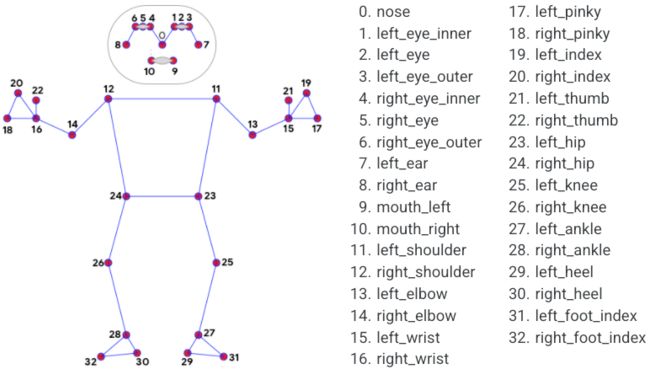俯卧撑计数 opencv-python + mediapipe
分享一个国外的趣味项目,俯卧撑计数自动计数项目,这个准确度还可以,考虑因素比较全,据说是新加坡军方使用的。
原文链接:https://aryanvij02.medium.com/push-ups-with-python-mediapipe-open-a544bd9b4351
github 地址: GitHub - aryanvij02/PushUpCounter: A simple program using Mediapipe and OpenCV to count the number of Push Ups done. The main goal is to ensure proper form while doing Push Ups so as to achieve maximum effect.
程序原理介绍
在新加坡军队中,有一种测试叫做IPPT(个人身体素质测试)。这个测试的困难不在于它对体力的要求有多高,而在于用来计算做俯卧撑和仰卧起坐次数的电子机器。
和大多数人一样,我的俯卧撑动作总是不达标(根据机器的意见)。此外,由于缺乏参照机器标准的练习,许多NSMen(已经完成两年强制性服役的人)在IPPT测试中都难以取得好成绩。
因此,我决定使用mediapipe和OpenCV创建一个程序,跟踪我们的俯卧撑动作,确保我们每一个俯卧撑动作都达标。
程序结构介绍
该项目有两个文件即可运行:
文件一:PoseModule.py
文件二:main.pyPoseModule.py
模块一:PoseModule.py 模块
上面的代码来源于PoseModule.py,有以下几个功能:
-
激活mediapipe的姿势检测模块。
-
检测人体。
-
根据模型找到人体上不同肢体关节的位置。(肢体显示在上面的图片中)。
-
查找关节之间的角度(取决于你选择的关节)。对于我的俯卧撑程序,我选择找到肘部、肩部和臀部的角度,因为这些对俯卧撑动作的标准至关重要。
源码如下:
import cv2
import mediapipe as mp
import math
class poseDetector():
def __init__(self, mode=False, complexity=1, smooth_landmarks=True,
enable_segmentation=False, smooth_segmentation=True,
detectionCon=0.5, trackCon=0.5):
self.mode = mode
self.complexity = complexity
self.smooth_landmarks = smooth_landmarks
self.enable_segmentation = enable_segmentation
self.smooth_segmentation = smooth_segmentation
self.detectionCon = detectionCon
self.trackCon = trackCon
self.mpDraw = mp.solutions.drawing_utils
self.mpPose = mp.solutions.pose
self.pose = self.mpPose.Pose(self.mode, self.complexity, self.smooth_landmarks,
self.enable_segmentation, self.smooth_segmentation,
self.detectionCon, self.trackCon)
def findPose(self, img, draw=True):
imgRGB = cv2.cvtColor(img, cv2.COLOR_BGR2RGB)
self.results = self.pose.process(imgRGB)
if self.results.pose_landmarks:
if draw:
self.mpDraw.draw_landmarks(img, self.results.pose_landmarks,
self.mpPose.POSE_CONNECTIONS)
return img
def findPosition(self, img, draw=True):
self.lmList = []
if self.results.pose_landmarks:
for id, lm in enumerate(self.results.pose_landmarks.landmark):
# finding height, width of the image printed
h, w, c = img.shape
# Determining the pixels of the landmarks
cx, cy = int(lm.x * w), int(lm.y * h)
self.lmList.append([id, cx, cy])
if draw:
cv2.circle(img, (cx, cy), 5, (255, 0, 0), cv2.FILLED)
return self.lmList
def findAngle(self, img, p1, p2, p3, draw=True):
# Get the landmarks
x1, y1 = self.lmList[p1][1:]
x2, y2 = self.lmList[p2][1:]
x3, y3 = self.lmList[p3][1:]
# Calculate Angle
angle = math.degrees(math.atan2(y3 - y2, x3 - x2) -
math.atan2(y1 - y2, x1 - x2))
if angle < 0:
angle += 360
if angle > 180:
angle = 360 - angle
elif angle > 180:
angle = 360 - angle
# print(angle)
# Draw
if draw:
cv2.line(img, (x1, y1), (x2, y2), (255, 255, 255), 3)
cv2.line(img, (x3, y3), (x2, y2), (255, 255, 255), 3)
cv2.circle(img, (x1, y1), 5, (0, 0, 255), cv2.FILLED)
cv2.circle(img, (x1, y1), 15, (0, 0, 255), 2)
cv2.circle(img, (x2, y2), 5, (0, 0, 255), cv2.FILLED)
cv2.circle(img, (x2, y2), 15, (0, 0, 255), 2)
cv2.circle(img, (x3, y3), 5, (0, 0, 255), cv2.FILLED)
cv2.circle(img, (x3, y3), 15, (0, 0, 255), 2)
cv2.putText(img, str(int(angle)), (x2 - 50, y2 + 50),
cv2.FONT_HERSHEY_PLAIN, 2, (0, 0, 255), 2)
return angle
def main():
detector = poseDetector()
cap = cv2.VideoCapture(0)
while cap.isOpened():
ret, img = cap.read() # ret is just the return variable, not much in there that we will use.
if ret:
img = detector.findPose(img)
cv2.imshow('Pose Detection', img)
if cv2.waitKey(10) & 0xFF == ord('q'):
break
cap.release()
cv2.destroyAllWindows()
if __name__ == "__main__":
main()
模块二:运行主程序模块PushUpCounter.py
实际的俯卧撑计数的代码。我们使用PoseModule并确定一个俯卧撑合格与否的标准。
import cv2
import mediapipe as mp
import numpy as np
import PoseModule as pm
cap = cv2.VideoCapture(0)
detector = pm.poseDetector()
count = 0
direction = 0
form = 0
feedback = "Fix Form"
while cap.isOpened():
ret, img = cap.read() # 640 x 480
# Determine dimensions of video - Help with creation of box in Line 43
width = cap.get(3) # float `width`
height = cap.get(4) # float `height`
# print(width, height)
img = detector.findPose(img, False)
lmList = detector.findPosition(img, False)
# print(lmList)
if len(lmList) != 0:
elbow = detector.findAngle(img, 11, 13, 15)
shoulder = detector.findAngle(img, 13, 11, 23)
hip = detector.findAngle(img, 11, 23, 25)
# Percentage of success of pushup
per = np.interp(elbow, (90, 160), (0, 100))
# Bar to show Pushup progress
bar = np.interp(elbow, (90, 160), (380, 50))
# Check to ensure right form before starting the program
if elbow > 160 and shoulder > 40 and hip > 160:
form = 1
# Check for full range of motion for the pushup
if form == 1:
if per == 0:
if elbow <= 90 and hip > 160:
feedback = "Up"
if direction == 0:
count += 0.5
direction = 1
else:
feedback = "Fix Form"
if per == 100:
if elbow > 160 and shoulder > 40 and hip > 160:
feedback = "Down"
if direction == 1:
count += 0.5
direction = 0
else:
feedback = "Fix Form"
# form = 0
print(count)
# Draw Bar
if form == 1:
cv2.rectangle(img, (580, 50), (600, 380), (0, 255, 0), 3)
cv2.rectangle(img, (580, int(bar)), (600, 380), (0, 255, 0), cv2.FILLED)
cv2.putText(img, f'{int(per)}%', (565, 430), cv2.FONT_HERSHEY_PLAIN, 2,
(255, 0, 0), 2)
# Pushup counter
cv2.rectangle(img, (0, 380), (100, 480), (0, 255, 0), cv2.FILLED)
cv2.putText(img, str(int(count)), (25, 455), cv2.FONT_HERSHEY_PLAIN, 5,
(255, 0, 0), 5)
# Feedback
cv2.rectangle(img, (500, 0), (640, 40), (255, 255, 255), cv2.FILLED)
cv2.putText(img, feedback, (500, 40), cv2.FONT_HERSHEY_PLAIN, 2,
(0, 255, 0), 2)
cv2.imshow('Pushup counter', img)
if cv2.waitKey(10) & 0xFF == ord('q'):
break
cap.release()
cv2.destroyAllWindows()有个需要注意的地方在第17-21行。确定从相机捕捉到的图像的分辨率,并在绘制俯卧撑计数的矩形时调整像素值,等等。(第68-82行)。
环境部署说明:
新建虚拟环境,无需安装其他框架
pip install mediapipe -i https://pypi.tuna.tsinghua.edu.cn/simple
pip install opencv-python -i https://pypi.tuna.tsinghua.edu.cn/simple
